 By Blake Fitch, CAPP
By Blake Fitch, CAPP
The City of Aspen, Colo., Parking Department was recently assigned the task of addressing a section of town and transforming it into an enforcement zone. The city has four residential parking zones–A, B, C, and D–that have been in effect since the inception of paid parking in 1995.
Initially, we had to determine the boundaries of the new zone. After many site visits and map creations, these boundaries were identified. To change this area into a new zone required input and buy-in from area residents, who first received a letter explaining the proposed changes. The next step was to hold an open house to understand how the residents felt about the changes. To the staff’s surprise, much of the feedback received was positive. Residents voiced frustration that the area had been used to store vehicles, including trailers, for quite some time, and said it was difficult to find available parking for themselves and their guests.
Upon approval from the city council, a proposal was implemented. After a couple of weeks, installation of new signage was complete. For the first week, we placed fliers on vehicles and trailers informing the owners of the newly implemented regulations. The second week, warning citations were issued to those that hadn’t moved. The third week of enforcement, regular citation were issued.
By the third week of enforcement, we learned that very few citations were issued. We credit this to the staff’s hard work, detailed planning, and public outreach that took place prior to implementation. What we learned is that an effective and repetitive public outreach program can make policy change go smoother.
Blake Fitch, CAPP, is parking operations manager for the City of Aspen, Colo.
